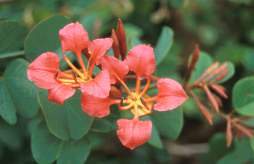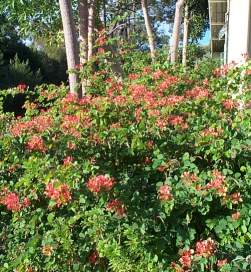Bauhinia galpinii
Bauhinia galpinii N.E.Br.
Family: Fabaceae
Common names: Pride of De Kaap (Eng); Vlam-van-die-Vlakte (Afr).
SA Tree No: 208.2
Introduction
With attractive brick red flowers from December onwards this scrambling shrub is a summer delight in many gardens.

Description
Description
In its wild state this medium to large shrub behaves more as a climber, clambering through the trees and shrubs of the dense thicket vegetation in which it occurs. It doesn't have to be grown in this fashion in your garden and with just a little pruning and training it can easily be trained into an attractive small tree or large garden shrub. Alternatively it can be encouraged in its clambering habit to cover pergolas or other structures and offer evergreen shade in your garden.
Distribution and habitat
Distribution description
As the name suggests, anyone could be forgiven for thinking that this plant comes from the Cape. In actual fact it is named after the De Kaap valley, south of Nelspruit in Mpumalanga in the northeastern region of South Africa. It is much more widespread, however, and can be found right across the moister bushveld areas of the country.
Ecology
Ecology
Certain butterfly larvae, that will eat the leaves and later pupate into beautifully coloured butterflies, favour this species.
Uses
Use
The long flexible branches of this tree are often used by the local people for weaving baskets and for the construction of roof trusses for their huts.

Growing Bauhinia galpinii
Grow
The pride of De Kaap is easy to cultivate and requires little attention once established. It is hardy to drought and moderate frost, but may need protection from frost in the first two or three years after planting. It produces its brick red flowers for a long period during the summer months from September to March but will also flower sporadically throughout the rest of the year.
This species requires space, even if it is to be regularly pruned, and is not suitable for the small garden. It does however come into its own in large gardens and estates where it may also form a good barrier plant along fences and boundaries.
The seeds germinate easily and are best sown in spring. Soaking the seeds in warm water overnight will speed up germination. After germinating the seedlings grow quickly and should be transferred into individual containers while they are still young.
Credits
Andrew Hankey
Witwatersrand National Botanical Garden
February 2001
Plant Attributes:
Plant Type: Scrambler, Shrub, Tree
SA Distribution: Gauteng, KwaZulu-Natal, Limpopo, Mpumalanga, North West
Soil type: Sandy, Loam
Flowering season: Early Summer, Late Summer
PH: Acid, Neutral
Flower colour: Red
Aspect: Full Sun
Gardening skill: Easy
Special Features:
Horticultural zones










Rate this article
Article well written and informative
Rate this plant
Is this an interesting plant?
Login to add your Comment
Back to topNot registered yet? Click here to register.